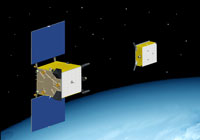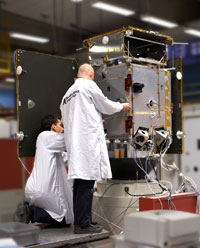THE PRISMA PROJECT.
The Prisma-satellites have separated.
The Swedish Prisma formation flying and rendezvous satellites, named Mango and Tango, have now been separated. The satellites have been clamped together since the successful launch in June.
(2010-08-12)
From the mission control center, the SSC engineers report:
”Telemetry indicated that Tango was free flying and had stabilised itself in a slowly rotating sun pointing attitude. Battery was nominal and solar array is working. Everything is fine aboard Tango. The GPS navigation shows that the relative trajectory is nominal: distance had increased to about 120m. The relative velocity at separation was at the right magnitude and the induced momentum was very good. Tango only had to remove a tumbling of about 1 deg/s. We got the first few images down to ground during the first pass after separation. All systems look to be working as expected.”
This was only the beginning, now the series of navigation experiments and flight demonstrations can begin. Follow the reporting from SSC’s mission control center at www.prismasatellites.se
SUCCESSFUL LAUNCH OF THE SWEDISH PRISMA SATELLITES
The Swedish Prisma satellites have been successfully launched aboard a Dnepr launcher from Yasny, Russia, today at 14.42 UTC. Sixteen minutes after launch, the two Prisma satellites were released, clamped together in launch configuration.
(Pressrelease: Swedish Space Corporation. 15th of June 2010)
The mission control center of the Swedish Space Corporation had its first contact with Prisma 16.14 UTC. The operations team could verify that the solar array panels had been deployed as planned and that the satellites are in a nominal state. During the coming days, all subsystems on both satellites will be successively verified, leading up to the planned separation of the satellites – Mango and Tango – on 3 August.
Prisma will demonstrate break-through technologies for autonomous formation flying and rendezvous. The mission comprises the verification of innovative systems for guidance, navigation and control, software and sensors as well as two propulsion systems. The series of experiments will commence after the separation in August and continue for ten months.
The Swedish Space Corporation (SSC) is the prime contractor for Prisma and has developed the major part of the onboard technologies and navigation experiments as well as the mission control software. The German Aerospace Center DLR, the French space agency CNES and the Danish University of Technology have contributed with navigation experiments, software and sensors.
The environmentally benign propulsion system and the micropropulsion system demonstrated onboard are developed by the SSC companies ECAPS and NanoSpace and make their first spaceflight on Prisma.
The Swedish National Space Board is the initiator of the Prisma mission and finances the project with support from the space agencies of France and Germany.
“Prisma is an excellent platform for the Swedish space industry to qualify its inventions in space”, says Olle Norberg, Director General of the Swedish National Space Board. “The mission will fortify Sweden’s position as a prominent technology nation and hopefully open doors to new international space projects where we can contribute.”
“SSC is a renowned player in the international space business”, says Lars Persson, CEO of the Swedish Space Corporation. “We really look forward to once again proving our capabilities in satellite development and control, and to the verification of our unique innovations such as the propulsion systems, which we expect to be very prosperous on the international market. We also appreciate the very rewarding cooperation we have with our European partners in this project.”
Technologies for autonomous formation flying and rendezvous are required in scientific missions where two or more spacecraft need to interact to form powerful antennas and telescopes. These innovations are also essential in missions that involve docking and inspections of satellites in orbit.
Prisma-satellites.
Arielspace has visited The Swedish Space Corporation in Solna (close to Stockholm) and had a look at the Prisma-satellites. They will be launched in 2009.

My visit to The Swedish Space Corporation:
In March 2008 I had the opportunity to join a specially invited group to the headquarter of The Swedish Space Corporation and listen to a speech delivered by Staffan Persson who is working at the Prisma-project. After the speech we were allowed to go down to the basement to have a look at the clean-room through a huge window. I felt entusiastic by this opportunity to watch two satellites that will actually be launched into space!
Chaos seemed to be reigning in the clean-room. Cables and big plastic bags were hanging from the satellites. The solar panels had been temporarily removed. A big part of the room was occupied by the huge table were all the parts are stored before they are assembled.
What is the Prisma-project?
Prisma is a Swedish-led satellite project with the objective to develop and qualify new technology necessary for future science missions in space, for example formation flying. Many of the future projects comprise formation flying and rendezvous, i.e. several spacecraft that can communicate and interact with each other with high precision and that requires exceptional accuracy in measuring and controlling the inter-satellite orientation.
The Prisma-project is not a scientific project. The purpose is instead to test new technology. Two satellites will be launched at the same time. One satellite goes by the name of Main and is a cube (the side is one meter). It has a propulsion system. The other satellite is smaller. It has no propulsion system but will stay in the original orbit. It is named Target. The satellites will be launched in 2009 by a Russian rocket, Dnepr.
Cooperation.
Several new Swedish and foreign technologies are already under development and will in different ways give new opportunities or render future space projects. Space missions are still expensive and entail high risks, therefore new technologies must be qualified in space before they are considered reliable. Sweden now grabs the initiative and develops a small scale flying test laboratory, Prisma – the rendezvous robots.
Formation flying requires high precision and makes great demands on geometry, sensors, actuators and guidance, navigation and control techniques. In this context, the Prisma project is Europe's first necessary step to demonstrate new technology - both hardware and software. The technology of Prisma is developed mainly in Sweden, Germany, Denmark and France.
Facts about Prisma.
Prisma consists of two spacecraft, one main spacecraft and one target spacecraft with a total mass of >200 kg. Prisma contains several new technologies within autonomous formation flying and rendezvous, small rocket engines and MEMS (Micro Electro Mechanical Systems). The total development budget for Prisma is just under 230 million SEK (24 million Euros).
The Swedish Space Corporation is the prime contractor and is also responsible for the project management, satellite design, development of the guidance, navigation and control system, the onboard computer, onboard software, the ground system and software, assembly, integration and verification, launch procurement and operations once the satellites are in orbit. Swedish subcontractors are Omnisys (power system), ECAPS (green propulsion system) and Saab Space (manufacturing of structure and some electronics).

Schedule.
Planning of the Prisma-project began at The Swedish Space Corporation in April 2005. During 2008 the parts are being put together in Solna. The next step is advanced testing. It will be conducted at Packforsk in Kista, Sweden, and Intespace in Toulouse, France.
Staffan Person told us that at Intespace they can simulate among other things the extreme cold of space and the radiation from the Sun.
Hopefully the satellites are ready to be shipped to Russia in January 2009. The launch will be from Baikonur (Kazakhstan) or Yasni (Russia) in June 2009.
The text above was compiled by information from a speech by Staffan Person at the Prisma-project and from the home-page of the project.
You can find out a lot more at www.prismasatellites.se
|